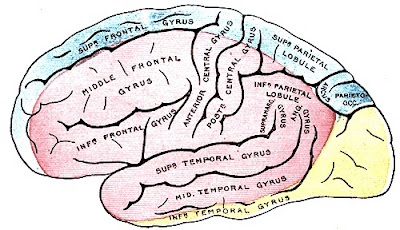PHOTO: The yellow shaded regions (lower right in figure) on outer surface of the human cerebral hemisphere (shown as side view with the back of the head to the right) is the area of the brain supplied by the posterior cerebral arteries in the region where I suffered an ischemic stroke and partial brain death due to the lack of blood. (Diagram is from article, "Posterior cerebral artery" wikipedia.org accessed Jul. 7, 2016)
In 2010, I first suffered an ischemic stroke in the posterior cerebral artery area (PCA) of my brain that caused prosopagnosia and topographical agnosia, which has made me low vision blind, asexual and severely limited in the amount of text I can read and write because just magnifying text doesn't solve my problem of being unable to see the first couple of letters in words and sentences. In addition, I have also been developing muscle weakness on my right side, which I hope doesn't lead to speech or mobility problems, and my condition has been worsening over time.
My low vision blindness allows me to see many things. My vision has been gradually worsening to the point where I can see 72-point newspaper headlines in perfect focus, but have trouble seeing the first few letters of each word or sentence, and the rest of the page looks like I am trying to display the whole page on a small computer monitor and so I can't see the smaller print. In addition, I have become more and more color blind, and I am now unable to see yellow and orange letters. Blue and black look the same to me, but I can still distinguish a red versus green traffic light.
My eye doctors originally thought I merely had a nuclear cataract, but the other symptoms I have are suggesting that most of my vision problems are due to a neurological source, perhaps related to the ischemic stroke I have suffered in 2010 and the subsequent, smaller strokes.
I have kept the following notes to remind myself of both my disability issues and the related medical terminology:
- agnosia is defined as loss of perception of certain things, such as a face, which is called prosopagnosia (from Greek for face no perception), despite being able to physically see them. (Also, see Dorland's Medical Dictionary 28th Edition 1994, p. 38)
- Agnosia, Wikipedia accessed Jul. 6, 2016 says, "Agnosia is the inability to process sensory information. Often there is a loss of ability to recognize objects, persons, sounds, shapes, or smells while the specific sense is not defective nor is there any significant memory loss. It is usually associated with brain injury or neurological illness, particularly after damage to the occipitotemporal border, which is part of the ventral stream."
- prosopagnosia known as face blindness and facial agnosia: Patients cannot consciously recognize familiar faces
- Simultanagnosia wikipedia.org accessed Jul. 6, 2016 is a rare neurological disorder characterized by the inability of an individual to perceive more than a single object at a time - in my case I can't see the first letter or two of words
- topographical is defined as being of or relating to the arrangement or accurate representation of the physical features of an area (e.g. topographical map)
- The symptoms of topographical agnosia, topographagnosia and Visuospatial dysgnosia are often linked with topographical disorientation. In my case, I have a sense of not knowing where I am relative to where I want to go, such as the store or doctor's office. I am unable to navigate and I get lost even in places that I am familiar with, and I am forced to use logic and memory to find things
- Visual agnosia wikipedia.org accessed Jul. 6, 2016 defines visual agnosia as an impairment in recognition of visually presented objects. It is not due to a deficit in vision (acuity, visual field, and scanning), language, memory, or low intellect. While cortical blindness results from lesions to primary visual cortex, visual agnosia is often due to damage to more anterior cortext such as the posterior occipital and/or temporal lobe(s) in the brain.
- Search areas of brain supplied by posterior cerebral artery
- Posterior cerebral artery wikipedia.org accessed Jul. 7, 2016
One symptom that has fascinated me is the fact that I have become asexual, but not impotent, because I can physically make everything work, even though I can no longer be aroused by looking at things that used to turn me on. Until I experienced being asexual firsthand, I was skeptical that anybody could be asexual, because many Catholic Priests claimed to be asexual, but in fact many of them were confirmed to be homosexuals, ephebeophiles or pedophiles. Oregon State University animal science research has confirmed the existence of gay, straight, bisexual and asexual animals in nature.
 PHOTO: Tess Jarmain escorts four male-oriented (homosexual) rams (a.k.a. "gay sheep") in Oregon State University's flock back to pasture. From Mary Ann Albright, "The science of rams and sexuality: Not all seek ewes," Gazette-Times, August 12, 2005 photo Tiffany Brown. Some of these sheep were found to be asexual. (See previous posts Bisexual erectile response scientifically measured despite skepticism by Dan Savage and others (8/10/11), Gay animals in New York Times (4/3/10) and OSU Gay Sheep NY Times (2/7/07))
PHOTO: Tess Jarmain escorts four male-oriented (homosexual) rams (a.k.a. "gay sheep") in Oregon State University's flock back to pasture. From Mary Ann Albright, "The science of rams and sexuality: Not all seek ewes," Gazette-Times, August 12, 2005 photo Tiffany Brown. Some of these sheep were found to be asexual. (See previous posts Bisexual erectile response scientifically measured despite skepticism by Dan Savage and others (8/10/11), Gay animals in New York Times (4/3/10) and OSU Gay Sheep NY Times (2/7/07))
Below are the signs and symptoms I experienced after the May 3, 2010 stroke. I was told these are textbook examples of problems associated with the area of brain that I had a stroke:
- Blood pressure lowered (without medication) to the same as what it was at age 21
- Abrupt vision loss due to stroke is not fully explainable by previous nuclear cataract diagnosis that explained slowly increasing nearsightedness and presbyopia
- Prosopagnosia -- unable to recognize familiar faces or buildings
- Topographical disorientation -- feel lost navigating in 3-D by sight and can't visualize where to put things back in kitchen, despite 16 years of familiarity with my kitchen
- Simultanagnosia -- unable to see whole page, pick out things, or tell if it is upside down
- Unable to see to-and-fro motions -- can't see fast moving objects
- Partial alexia -- unable to see first few letters of words and must guess at them to read
- Achromatopsia -- color intensity reduced and unable to differentiate between colors
- Photophobia hemeralopia -- store fluorescent lights seem bright - reduced vision
- Macropsia -- street trees seem to be much larger than before
- Palinopsia -- seeing double images of text went away after stroke
- Asexual, but not impotent -- no sexual arousal or erection from any visual stimulus
- Sense of calm and no formed hallucinations -- easy to make cry after stroke
See previous posts and links:
- My low vision blindness is like seeing a captcha all the time (1/1/12)
- I am in hospital, but alive -- for now (5/5/10) "UPDATE 5/19/10: I am now out of the hospital, but my visualization and 3-D navigation skills are poor. "
- Stroke-related Blindness slows me down more (2/5/11)
- Signs and symptoms due to stroke (9/18/10)
- Are some ex-gays truly asexual and chose to be gay like Chaz Bono did (6/22/11)
- Kinsey scale and asexuality 1948 (9/16/06)
- Face recognition vs. sexual orientation, handedness, and sex (1/15/11)
- "A Boi's Life" and "Chaz Bono" (6/14/09)
- Lying about gay sex in fMRI scan (9/5/10)
- Bisexual erectile response scientifically measured despite skepticism by Dan Savage and others (8/10/11)
- OSU Foundation Magnus Hirschfeld Fund Agreement (1/4/12)
- Obituary for Thomas Kraemer (1/4/12)
- Oregon POLST for Thomas Kraemer (12/4/13)
